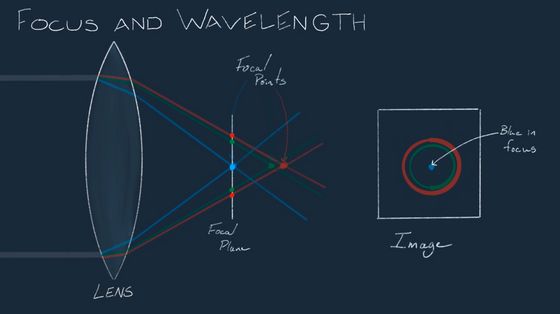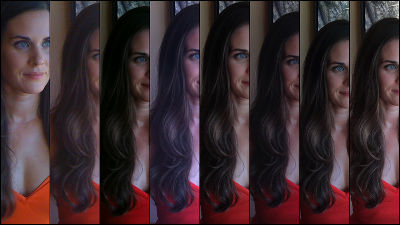Why is it difficult for the human eye to focus on 'blue'?

People casually see blue accessories and furniture, the blue sky and the sea on a sunny day. However, in reality, it seems difficult for the human eye to focus on blue light, and science blogger Caleb Kruse explains why.
Focusing on Blue --10 Projects
Kruse points out that in order to know what is happening to the human eye, it is necessary to understand how light moves and how the lens focuses the light. First, the speed of light is not always constant and depends on the medium through which the light travels. For example, the speed of light moving in a vacuum is about 300,000 km per second, but when moving in glass, the speed drops to about 50 to 70%.
Also, when light travels from one medium to another, it not only changes its speed, but also its direction. The change in velocity and angle of light traveling from one medium to another is indicated by Snell's law , and the angle of incidence on the surface of the medium and the refractive index of the medium determine the direction of light travel.
'Lens ' are made using Snell's law. Light that enters parallel to the lens is polarized according to the curved surface of the lens, the angle of incidence, and the refractive index of the lens, creating a single focal point after exiting the lens. By focusing this focus on the human retina, humans can obtain clear images. Below is an image created by Kruse to explain how the lens refracts light to create focus. You can see that the light is refracted not only when it enters the lens but also when it exits the lens.

In the above example, it is assumed that the wavelength (color) of light is constant, but the actual natural light source is composed of light of various colors, and even white light can be blue, green, red, etc. Contains light of various colors. And because the index of refraction of light varies by color, each color component contained in white light is split to refract at different angles and does not exactly converge to a single focal point. The image shift caused by color dispersion is called

Since the focus is different depending on the color of the light, there is no single position where all the colors coming from the lens are in focus. While modern camera lenses have special coatings that can address this issue, relatively simple lenses, including the human eye, do not have a mechanism to correct chromatic aberration. Therefore, instead of correcting chromatic aberration, the human eye has chosen the method of 'cutting off the blue light and placing the focal plane in a place where the green and red light can be easily seen,' Kruse said. I am explaining.
If you look at the image below, you can see that if the focal plane is placed in a place where the blue light is easily visible, the red light and green light whose focal positions are far apart from the blue light do not gather at one point on the focal plane. .. In this case, the red and green lights will look blurry.

On the other hand, green light and red light are relatively close to each other, so if you place the focal plane in a position where you can easily see these lights, you can clearly see at least two colors. For this reason, Kruse says that the human eye has given up looking at blue light clearly and is focusing on the vicinity of green and red light.

Kruse uses images of the Earth as an example of how humans can be seen not focusing on blue. The image below is a picture of the Earth taken by the National Oceanic and Atmospheric Administration (NOAA) and NASA.

The image below is a blur of the green light element extracted by Mr. Kruse from the original image. You can see that the image of the earth is also blurred overall.

On the other hand, in the image below, which is a blurred element of blue light, the appearance of the earth can be seen clearly. In other words, humans usually recognize blue light in a blurred state, so even if the blue light is intentionally blurred, it does not feel strange.

'I think this concept is great,' Kruse said of how the human brain extracts some color information from blue light while relying on green and red light for image clarity. .. 'Our eyes are often thought of as the perfect camera, but it is the brain that adjusts all the optical flaws to solve the world,' he said.
Related Posts:
in Science, Posted by log1h_ik







